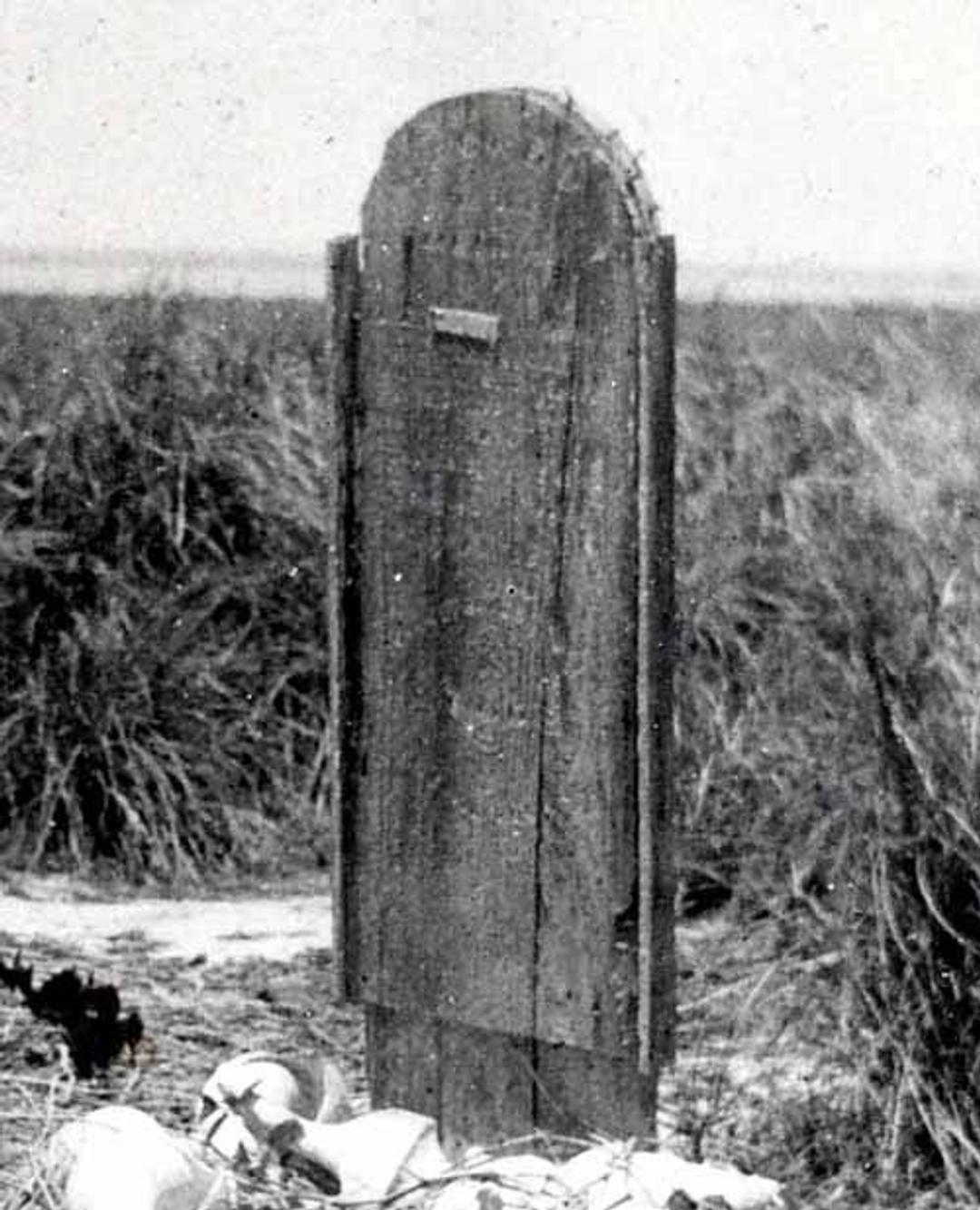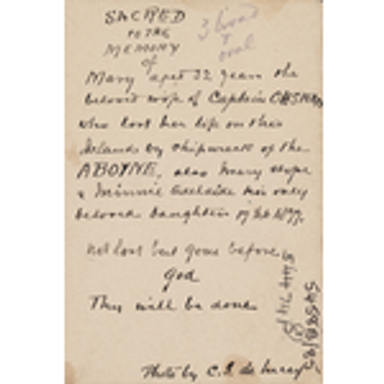Aboyne
Vessel Name: Aboyne
Mary Swan
2 daughters, 4 years and 9 months old
Charles Goodwin
Henry Gerald F. Parker
Peter Berthelsen
Henry Huxley
Drowned when vessel was destroyed by cyclone
18 March 1877




Captain George H Swan was a lifelong seafaring captain. So much so, that his wife Mary and two daughters lived aboard with him. This was not a common practice, but neither was it unusual. A captain’s wife filled many roles; nurse, counsellor, seamstress, educator, and provided a level of civility that could easily be forgotten on long voyages. There is no cook in the Aboyne’s crew list, so it is possible that Mary Swan was the cook. The Swans voyages had brought them from England to Western Australia.
Aboyne was built in London and registered there in 1864. She was a barque [3 masts] measuring 184 feet [56.1 metres] long, 26.2 feet [7.9 metres] wide and drew 15.2 feet [4.6 metres] of water. Her aft-most mast was rigged fore and aft, and her main mast had square rigging. She was owned by a W. Moodie and Company. Her official number was 48681.
Aboyne left New South Wales on 20 September 1876, bound for the Lacepedes Islands, 30 kms from the Dampier Peninsula. She was engaged to carry guano for use as fertiliser. The main islands are West Island, Middle Island, Sandy Island and East Island, located close to each other. In 1877 West Island was the source of guano. Her crew list for 1876 was:
George H Swan, Captain
John Waldren, Mate, 25, British
James S Garrish, 2nd Mate, 20, British
Peter Berthelsen, Carpenter, 23, Denmark
Oscar Yanzar, Crew, 23, Foreign
Paul Dormavich, Crew, 22, Foreign
Nicolo Nidish, Crew, 23, Foreign
Henry Huxley, Ship's Boy, 16, British
G. Poole, Crew, 28, British
Alfred R Curtis, Crew, 19, British
Robert Ramage, C & S, 44, St. Helens
James Waggell, Crew, 20, Poole
Charles Goodwin, Apprentice, 16, British
Henry Gerald Foster Parker, Apprentice, 17, Irish
Mary Swan, wife of Captain Swan
Child Swan, 4 years
Child Swan, 9 months
It was a long haul. Aside from the voyage to the Kimberley coast, guano vessels often waited for a month or longer before they could load their cargo. Each of the 70 vessels carting guano from the islands were granted priority loading in their contract, which was not possible. Some captains bribed the government representative Wynne on the islands to permit them to load sooner than the others. Captain Swan made his displeasure known, which negatively affected his relationship with Wynne and some of the other captains.
An average loading schedule was eight tons per day, and the Aboyne carried 445 tons burthen [cubic capacity calculated by length and beam]. On 17 March, Aboyne had been anchored off West Island for 77 days. She had loaded approximately 100 tons of guano.
On 17 April the weather deteriorated and it became obvious a cyclone was coming. Most of the guano vessels had passed their prime or had been previously damaged. They were often leaky. As the West Australian newspaper reported, they were "paltry old boats". They did not handle bad weather well.
Amur, Emily and Star of Jamaica put out to sea before the weather deteriorated further. Bessie had left a few days earlier to fetch water and supplies for the islands. Express was on her way to the islands and met the cyclone at sea without harm.
There were six vessels remaining anchored at the islands: Aboyne, Helen Malcolm 311 tons, Mary Smith 150 tons, Cingalese, Isabella 268 tons and Albert Victor 384 tons. Some were partially loaded, and others were undecided about the best course of action. Captain Wills on Prince Arthur rode out the cyclone at anchor without any real damage.
Captain Swan put his wife and two daughters in their cabin and asked the apprentice Henry to remain with them.
Between 8 and 9am on 17 March 1877 the wind suddenly shifted from the east to NNE and large breakers began to force the anchored vessels towards the beach. By 10am the captains signalled each other. They had little choice but to attempt to beach their vessels. Captain Swan asked the other vessels to signal agreement they would make the attempt, understanding they risked losing their boats and crews. It was agreed they would beach the boats at 1pm, the next high water.
By 1pm the weather had worsened, and the sea threatened to submerge West Island. The barque Cingalese lowered her sails, slipped her chains and ran for the beach. The sea broke over her. Aboyne and the barque Mary Smith followed quickly. Mary Smith was carried on a wave high onto the beach but landed fairly well. The crews of Cingalese and Mary Smith rushed towards the Aboyne ready to help her crew.
The Aboyne struck ground earlier than the other boats and landed on a shoal patch with loose coral and boulders approximately ¼ mile east of the other boats. She fell, decks to leeward and the sea rolled over her. The guano on board moved violently in the hold as she bounced on the bottom. The sea smashed her hard. Her aft mast fell to the side, taking the rigging down and pulling the main mast along with it. Aboyne was destroyed in 20 minutes.
The brig Isabella followed and landed without loss to her crew. The barques Helen Malcolm and Albert Victor followed Aboyne and suffered a similar fate, breaking up in the heavy seas.
The people already on shore and the survivors from the guano vessels could only watch as the boats broke up. They organised themselves and began to search for survivors.
At 3am on 25th March the body of a four-year-old girl was washed ashore. At daylight a party went to the western side of the island and found a nine-month-old girl, and one of the apprentices. He had a leg and both arms missing, bitten away by sharks. A bit further along the beach were the bodies of the second apprentice and Mrs Swan. Her body was badly mutilated.
In the afternoon the body of the carpenter Peter Berthelsen was found floating towards the shore. Before anyone could bring the body ashore, sharks attacked and ate it. Peter landed safely on shore initially, but he went back to help others out of the wreck. He was caught by a retreating wave and drawn under the boat. The boat rolled on top of him and crushed him. His remains were wrapped in sailcloth for burial.
Captain Swan buried his wife and daughters together on West Island and left a wooden cross decorated by creeping plants. There is a tombstone marking the grave site. The crew were wrapped in sailcloth and buried in two large common graves in the same site on West Island.
The Prince Arthur took the crews from the wrecked vessels from Lacepedes Islands to Fremantle. There were 82 people from Aboyne, Albert Victor, Helen Malcolm and Isabella. Captain Cook of the Mary Smith remained behind to attempt to refloat her. Seventy men from vessels including those belonging to Messrs Poole, Pickens and Company remained behind also. Some of the men left on the islands were loading crews who lived there. The crew of Mary Smith later returned to the mainland with the Assyrian when it became clear their vessel could not be saved.
The wrecks were auctioned by Messrs George Thompson & Co. at Fremantle on 6 April 1877. John and Walter Bateman, ship owners, bought the Cingalese for £170. The remaining vessels including Aboyne were bought together as salvage for £340 by a company who was represented by well-known Captain Owson.
On his return to Fremantle, Captain Swan wrote to the local Herald newspaper and submitted a thank you to those who cared for him after his return from Lacepedes Islands. He sustained serious injuries during destruction of the Aboyne. Heart-broken at the loss of his family, and his vessel which was his home, Captain had lost everything. He returned to England when he was well enough to make the voyage.
To the Editor of the Herald
SIR,
Would you kindly oblige me by allowing me
through your valuable paper to return my
sincere thanks to the shipmasters and
inhabitants of Fremantle for their kindness
in assisting me in obtaining my passage to
England.
I am dear sir,
Yours respectfully,
GEO. H. SWAN
Master of the late barque “Aboyne”.
Fremantle, April 17, 1877.
In 1931 newspapers took up a strange tale which was quickly circulated through multiple papers throughout the state. It told the tale of a crew member of the Albert Victor who was dismissed in 1876 from his position aboard when the captain found him mistreating the ship’s boy. The man’s name was Symonds, reputably a ruffian. Symonds abused the captain and the boat and proceeded on a pub crawl along the pier in Melbourne repeating his curses. Symonds declared the Cingalese, Albert Victor and Helen Malcolm were a “pack” of boats only good for guano carting, and he said they would never carry guano again. The following March these boats and others were wrecked at the Lacepedes Islands in a cyclone. Newspapers said the drunk man’s prophecy had been realised.
